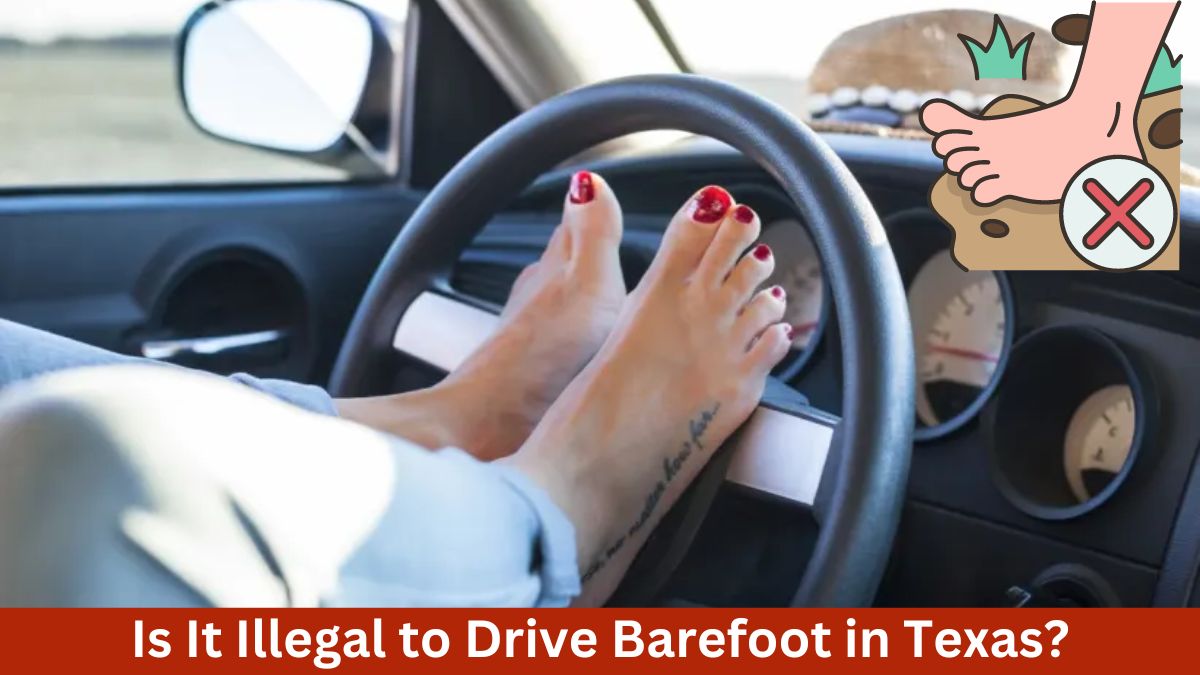Driving barefoot is a topic that often sparks curiosity and debate among drivers. While some may find it comfortable, others may question its legality and safety. This article delves into the specifics of driving barefoot in Texas and explores relevant traffic laws across the United States. We’ll provide a comprehensive overview of whether driving barefoot is illegal, the safety considerations involved, and insights into traffic regulations in various states.
Definition and Common Perceptions
Driving barefoot means operating a vehicle without wearing shoes. While this practice might seem unusual to some, many drivers prefer it for comfort or ease of control. The perception of driving barefoot varies widely, with some considering it a personal choice and others viewing it as unsafe or impractical.
Historical Context and Evolution of Traffic Laws
Traffic laws have evolved significantly over time, focusing on ensuring road safety and minimizing accidents. Historically, specific regulations about footwear were not a major concern, but as safety awareness increased, so did the scrutiny of various driving practices. The emphasis has generally been on ensuring drivers can operate their vehicles safely, rather than regulating specific aspects such as footwear.
Texas Traffic Laws and Driving Barefoot
Specific Texas Laws Regarding Footwear While Driving
In Texas, there is no specific law that prohibits driving barefoot. The Texas Department of Public Safety (DPS) has stated that while there is no regulation against driving without shoes, drivers are required to operate their vehicles safely. The absence of explicit footwear laws means that driving barefoot is not illegal per se. However, drivers must ensure that their driving practices do not compromise safety.
Safety Considerations and Guidelines
While driving barefoot is not illegal, it is essential to consider the potential safety implications. Barefoot driving might affect your ability to control the vehicle effectively, especially in emergency situations. The Texas DPS recommends that drivers wear appropriate footwear that provides adequate control and protection. Proper footwear helps in maintaining a firm grip on the pedals and can prevent injuries in case of an accident.
Case Studies or Examples from Texas
Several anecdotal accounts suggest that drivers in Texas have successfully driven barefoot without issues. However, there are also reports of incidents where barefoot driving led to challenges, such as slipping off the pedals or difficulty in operating the vehicle efficiently. These examples highlight the importance of considering safety and comfort when choosing to drive barefoot.
Traffic Laws on Driving Barefoot Across the United States
Comparative Analysis of Different State Laws
In the United States, traffic laws regarding driving barefoot vary widely from state to state. Some states have specific regulations, while others rely on general safety guidelines. Here’s a comparative analysis of how different states approach this issue:
- California: There are no specific laws prohibiting barefoot driving in California. However, drivers are expected to operate their vehicles safely, and any unsafe driving practices, regardless of footwear, could result in penalties.
- Florida: Similar to California, Florida does not have explicit laws against driving barefoot. The emphasis is on the driver’s ability to maintain control of the vehicle and drive safely.
- New York: New York does not specifically address barefoot driving in its traffic laws. The focus remains on ensuring that drivers can control their vehicles effectively, regardless of whether they are wearing shoes.
- Ohio: In Ohio, there are no laws prohibiting barefoot driving. The state’s traffic regulations emphasize safe driving practices rather than regulating footwear.
- Colorado: Colorado does not have specific laws about driving barefoot. The state’s traffic regulations are centered around safe vehicle operation and control.
States Where Driving Barefoot is Explicitly Addressed
A few states explicitly mention driving barefoot in their traffic regulations:
- New Jersey: New Jersey law does not prohibit driving barefoot, but the state’s guidelines recommend wearing appropriate footwear to ensure safe vehicle control.
- Arizona: Arizona’s traffic laws do not ban driving barefoot. However, drivers are advised to use proper footwear to avoid potential safety issues.
States Where No Specific Law Exists but Safety is Emphasized
In many states, there are no specific laws about driving barefoot, but general safety regulations apply. These states include:
- Michigan
- Georgia
- Tennessee
- South Carolina
In these states, while driving barefoot is not illegal, drivers must ensure their driving practices do not compromise safety.
Safety Considerations of Driving Barefoot
Risks and Benefits of Driving Without Shoes
Driving barefoot presents both risks and benefits.
Risks:
- Reduced Pedal Control: Without shoes, it may be harder to control the accelerator, brake, and clutch pedals, especially in emergency situations.
- Injury Risk: Bare feet are more vulnerable to injuries, such as cuts or burns from the pedals or floor of the vehicle.
Benefits:
- Enhanced Sensation: Some drivers feel they have a better sense of control and responsiveness when driving barefoot.
- Comfort: For some, driving barefoot is simply more comfortable, especially on long journeys.
Expert Opinions and Statistical Data
Experts generally agree that driving barefoot can be risky. According to safety organizations and driving instructors, wearing appropriate footwear provides better pedal control and reduces the risk of accidents. While there is limited statistical data specifically on barefoot driving, general driving safety studies emphasize the importance of proper footwear.
Recommendations from Safety Organizations
Safety organizations, such as the National Highway Traffic Safety Administration (NHTSA), recommend wearing shoes while driving. Shoes provide better pedal control and protection, enhancing overall driving safety. While driving barefoot is not illegal, following these recommendations can help prevent potential accidents and ensure safe driving practices.
Conclusion
Summary of Key Points
Driving barefoot is not explicitly illegal in Texas or many other states. While no specific laws prohibit barefoot driving, drivers are required to operate their vehicles safely. The absence of regulations does not mean that driving barefoot is always safe or advisable. Safety considerations, such as pedal control and injury risk, highlight the importance of wearing appropriate footwear while driving.
Final Thoughts on Driving Barefoot and Its Legal Implications
In conclusion, while driving barefoot may be allowed in many states, it is crucial to prioritize safety. Drivers should consider the potential risks and benefits of driving without shoes and adhere to general safety guidelines to ensure they can operate their vehicles effectively. Ultimately, the focus should be on maintaining control and driving safely, regardless of footwear.
This Article Includes






